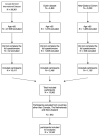Cross-Country Differences and Similarities in Undernutrition Prevalence and Risk as Measured by SCREEN II in Community-Dwelling Older Adults
- PMID: 32498433
- PMCID: PMC7349548
- DOI: 10.3390/healthcare8020151
Cross-Country Differences and Similarities in Undernutrition Prevalence and Risk as Measured by SCREEN II in Community-Dwelling Older Adults
Abstract
Undernutrition is highly prevalent among community-dwelling older adults. Early identification of nutrition risk is important to prevent or treat undernutrition. This study describes the prevalence rates of nutrition risk in community-dwelling older adults (aged ≥ 65) using the same validated tool across different countries and aims to identify differences in nutritional risk factors. Cross-sectional data was obtained from three datasets including participants from the Netherlands (NL), Canada (CA) and New Zealand (NZ). Seniors in the Community Risk Evaluation for Eating and Nutrition II (SCREEN II) was used to assess nutritional risk factors and prevalence of risk. Differences between countries were tested with logistic and linear regression. Sensitivity analyses were conducted to test the influence of sampling strategy. A total of 13,340 participants were included, and 66.3% were found to be at high nutrition risk. After stratifying the data for method of data sampling, prevalence rates showed some differences across countries (NL: 61.5%, NZ: 68.2%, CA: 70.1%). Risk factor items that contributed to nutrition risk also differed among countries: NZ and CA participants scored higher for weight change, skipping meals, problems with meal preparation, use of meal replacements, problems with biting and chewing, low fluid intake and problems with doing groceries, as compared to participants in NL. Low intake of fruits and vegetables and meat were more prevalent in NL. In conclusion: nutrition risk is a worldwide, highly prevalent problem among community-dwelling older adults, but risk factors contributing to nutrition risk differ by country.
Keywords: SCREEN II; community-dwelling older adults; malnutrition; nutritional risk; risk screening; screening tools; self-screening; undernutrition.
Conflict of interest statement
The authors declare no conflict of interest.
Figures
Similar articles
-
Prevalence and Determinants of Undernutrition in A Sample of Dutch Community-Dwelling Older Adults: Results from Two Online Screening Tools.Int J Environ Res Public Health. 2019 May 4;16(9):1562. doi: 10.3390/ijerph16091562. Int J Environ Res Public Health. 2019. PMID: 31060212 Free PMC article.
-
The ConsuMEER study: a randomised trial towards the effectiveness of protein-rich ready-made meals and protein-rich dairy products in increasing protein intake of community-dwelling older adults after switching from self-prepared meals towards ready-made meals.J Nutr Sci. 2019 Sep 5;8:e30. doi: 10.1017/jns.2019.27. eCollection 2019. J Nutr Sci. 2019. PMID: 31523425 Free PMC article. Clinical Trial.
-
What do screening tools measure? Lessons learned from SCREEN II and SNAQ65.Clin Nutr ESPEN. 2020 Aug;38:172-177. doi: 10.1016/j.clnesp.2020.05.008. Epub 2020 Jun 17. Clin Nutr ESPEN. 2020. PMID: 32690153
-
Validity of Nutritional Screening Tools for Community-Dwelling Older Adults: A Systematic Review and Meta-Analysis.J Am Med Dir Assoc. 2019 Oct;20(10):1351.e13-1351.e25. doi: 10.1016/j.jamda.2019.06.024. Epub 2019 Aug 10. J Am Med Dir Assoc. 2019. PMID: 31409560
-
Identifying the elderly at risk for malnutrition. The Mini Nutritional Assessment.Clin Geriatr Med. 2002 Nov;18(4):737-57. doi: 10.1016/s0749-0690(02)00059-9. Clin Geriatr Med. 2002. PMID: 12608501 Review.
Cited by
-
Effects of Oral Nutritional Supplement with β-Hydroxy-β-methylbutyrate (HMB) on Biochemical and Hematological Indices in Community-Dwelling Older Adults at Risk of Malnutrition: Findings from the SHIELD Study.Nutrients. 2024 Jul 31;16(15):2495. doi: 10.3390/nu16152495. Nutrients. 2024. PMID: 39125374 Free PMC article. Clinical Trial.
-
Factors associated with health-related quality of life among community-dwelling older adults: the APPCARE study.Sci Rep. 2024 Jun 21;14(1):14351. doi: 10.1038/s41598-024-64539-x. Sci Rep. 2024. PMID: 38906882 Free PMC article.
-
Nutrition Risk, Resilience and Effects of a Brief Education Intervention among Community-Dwelling Older Adults during the COVID-19 Pandemic in Alberta, Canada.Nutrients. 2022 Mar 6;14(5):1110. doi: 10.3390/nu14051110. Nutrients. 2022. PMID: 35268084 Free PMC article. Clinical Trial.
-
Nutritional status and dietary habits in older adults with fixed implant dental prostheses: a case-control study.Front Nutr. 2024 Sep 26;11:1373372. doi: 10.3389/fnut.2024.1373372. eCollection 2024. Front Nutr. 2024. PMID: 39391684 Free PMC article.
-
Social Factors Associated With Nutrition Risk in Community-Dwelling Older Adults in High-Income Countries: Protocol for a Scoping Review.JMIR Res Protoc. 2024 Jun 25;13:e56714. doi: 10.2196/56714. JMIR Res Protoc. 2024. PMID: 38696645 Free PMC article.
References
-
- WHO . Global Health and Aging. WHO; Geneva, Switzerland: 2011.
-
- Volkert D., Kiesswetter E., Cederholm T., Donini L.M., Eglseer D., Norman K., Schneider S.M., Ströbele-Benschop N., Torbahn G., Wirth R., et al. Development of a Model on Determinants of Malnutrition in Aged Persons: A MaNuEL Project. Gerontol. Geriatr. Med. 2019;5:1–8. doi: 10.1177/2333721419858438. - DOI - PMC - PubMed
-
- Phillips M.B., Foley A.L., Barnard R., Isenring E.A., Miller M.D. Nutritional screening in community-dwelling older adults: A systematic literature review. Asia Pac. J. Clin. Nutr. 2010;19:440–449. - PubMed
-
- Power L., Mullaly D., Gibney E., Clarke M., Visser M., Dorothee V., Bardon L., de van der Schueren M.A.E., Corish C. A review of the validity of malnutrition screening tools used in older adults in community and healthcare settings—A MaNuEL study. Clin. Nutr. 2018;24:1–13. doi: 10.1016/j.clnesp.2018.02.005. - DOI - PubMed
LinkOut - more resources
Full Text Sources


